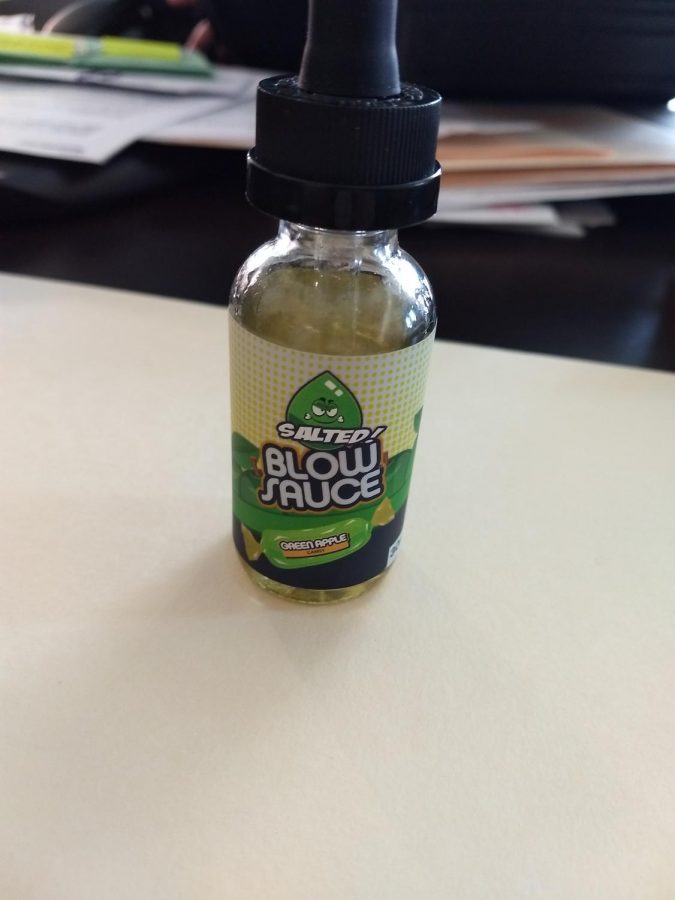Vaping Has Been Clouding the Bathrooms of Erie High School
Vaping is Taking its Toll on High Schools Across Colorado
March 4, 2019
Walking into high school bathrooms, there’s a high chance that you can catch fruity flavors wafting in the air from a JUUL, Sourin, or maybe even a Mod.
In the past few years e-cigarettes have been advertised as a better alternative for smokers to consume and even slowly wean off nicotine. But more kids in high school and even middle school take part in the act of breathing in the vaporized nicotine liquid. Schools across Colorado have struggled with students vaping for a few years, including Erie High School. Mrs. Molly Irwin, Erie High School Campus Supervisor, goes to a district meeting for all campus supervisors and claims that the vaping epidemic is “Vapes across the districts, it’s at every school.”
Exciting flavors like blue raspberry and honeydew watermelon have kids drawn into the new addiction. Mr. Paul Stecina, Dean of Students at Erie High School, explains that “They market them specifically towards kids, with the bubblegum and watermelon and all the different flavors that appeal to kids. The adults that vape tend to like the ones that don’t taste like that, the ones that taste like stereotypical tobacco taste.”
Not only do the fun flavors easily attract adolescents, but the aesthetic and the concealability ease also draws teens in. The newest devices such as the JUUL, which looks similar to a USB drive, and the Sourin, which could easily be mistaken for a phone or a portable charger, make it easy to hide the new toys in class. The look of the latest devices has made the vaping even more popular since it seems easier to hide from adults.
Compared to the easily identifiable smoke and smell of cigarettes, vaping seems to be a more pleasant activity, not to mention much easier to get away with. Irwin remembers eleven years ago during her first year working at Erie, when cigarettes were still the problem. “We had kids who would go up on the hill and they would smoke off of school property and so they would go up there and be smoking and they would go off school property to do it.” Irwin explains, that it “takes the time to smoke that cigarette. Whereas now it’s a fruity, pleasant smell and they can hit it wherever they want, they don’t have to take that time.”
With all the fun ingredients mixed together, it’s a recipe for addiction. According to Mary Ellen Flannery’s article Vaping in Schools: 3 Million and Counting, “each JUUL cartridge contains roughly the same amount of nicotine as 20 cigarettes.”
In fact, one cigarette has 1 milligram of nicotine. When it comes to the vape liquid you can get anywhere from 3 to 50 milligrams in the solution. With that much nicotine, it can be easy to become addicted. An anonymous student who takes part in it at Erie stated “Well when you first started out you’d feel really light and your body’s really tingly and that’s the buzz but I don’t really get that anymore. It’s more of a habitual thing.”
Stecina notes, “I can tell you just based on observation that there are way more people getting addicted to nicotine that there were five, ten years ago, even back to my generation.”
Stecina, who has battled with nicotine since he was sixteen, explains how nicotine can even affect your confidence, “When your body gets used to that heightened feeling that you think you’re smarter. Like if I use nicotine I can take this test better but your answers are the same you’re just more confident.”
One of the reasons so many people have given into the addiction is due to teens sharing vapes with each other just for fun, it’s simply something everyone is doing. As one student, when asked why they started, put it, “There wasn’t really a reason why it was just fun.”
Many are under the impression that vapes are nowhere near as bad as cigarettes, so they have to be okay. However, claims of the e-cigarettes safety are simply based on the reduced amount of chemicals in the liquid. In the American Medical Association’s “Tobacco Harm Reduction: A Comprehensive Nicotine Policy to Reduce Death and Disease Caused by Smoking,” Robert A. Gilchick notes that there is an “absence of randomized controlled trials and longitudinal observational studies on the effects of switching from combustible tobacco cigarettes to e-cigarettes to reduce harm.”
Gilchick also reminds his readers that “Tobacco products in any form are harmful and addictive and can cause disease and death.”
It’s possible that e-cigarettes are better than cigarettes but as Gilchick has reminded us there have been no real trials to test this theory’s accuracy. Not to mention that e-cigarettes are not a harmless toy, they are still a tobacco product that can be harmful. Gilchick also stated six times that “limited data are available on the long-term health effects of these products.”
We have no idea what could happen in ten years to those who vape. Already, people are developing Popcorn Lung. Popcorn Lung was first seen in workers in a microwavable popcorn factory, triggered from inhaling the synthetic butter in the bags. Popcorn Lung irritates and inflames the tiny airways called alveoli in the lung, causing them to become narrower. The narrow passageways make it difficult to get enough air in. Diacetyl is one of the chemicals that bring on the condition, which just so happens to be found in vape liquid as well.
The worst part of the entire situation is that most teens have no idea what they are inhaling. Irwin claims that the kids she brings in, “look at it as it’s not nicotine it’s just vape.”
How could such a fun flavored, easily concealable device be harmful when it’s only vape? Whether our generation realizes the risks or not, it does not change the fact that after taking a survey of 206 students in Erie High School’s hallways, 21% of students had tried it at least once, 10% did it at least once a month, 10% enjoyed it at least once a week, and 27% do it daily. The highest numbers were 38% of senior girls and 29% of sophomore boys who vape once a day.
E-cigarettes’ appearance seemed to be with good intentions towards those trying to get off nicotine. However, the product has impacted more kids with the fun flavors and easily concealed devices. Flannery states that “15- to-17-year-olds are more than 16 times more likely to be JUUL users than 25- to 34-year-olds.” The long term effects may not yet be visible but but nicotine addictions in teens have already been born. With vapes so popular amongst all groups and cliques, it’s undeniable that our generation has given in to the vape clouds and the nicotine dependency.







































Camie Nemeth • Mar 17, 2019 at 10:49 am
Great article Kailey! Vaping seems to be the “elephant in the room” and I applaud you for making it a headline. Vaping is something that is affecting all kids, whether they are doing it, feeling pressured to try it, or trying to stay away from it. I really like how you approached it from multiple angles and view points. Hopefully the conversation will continue. Nice work!